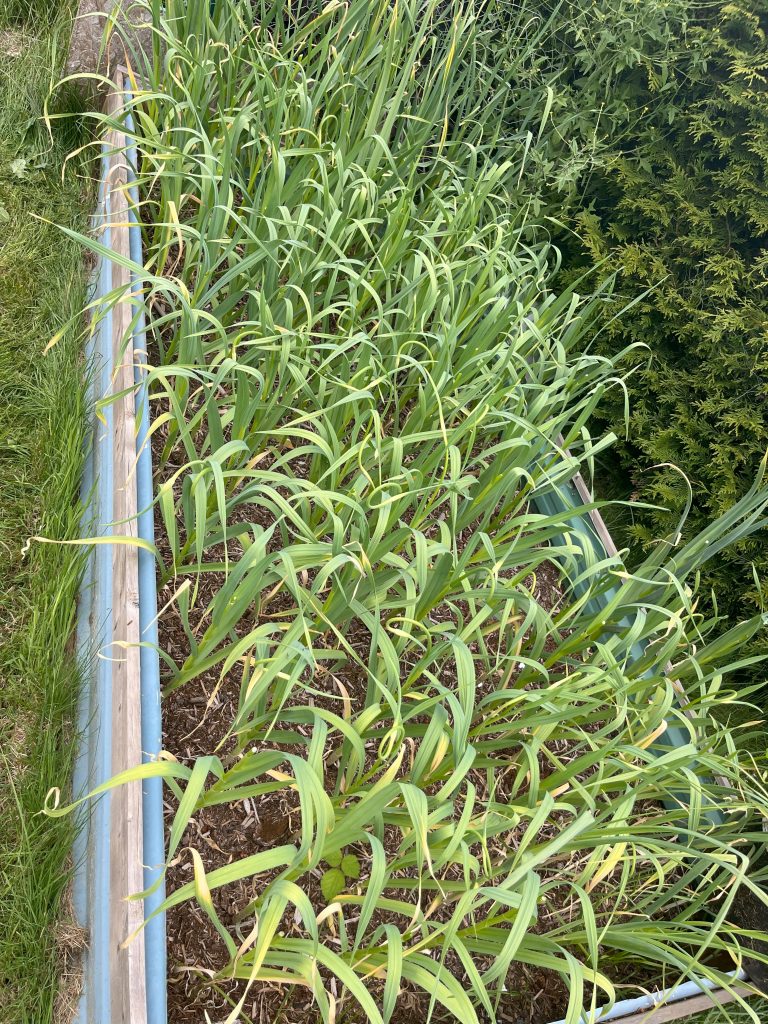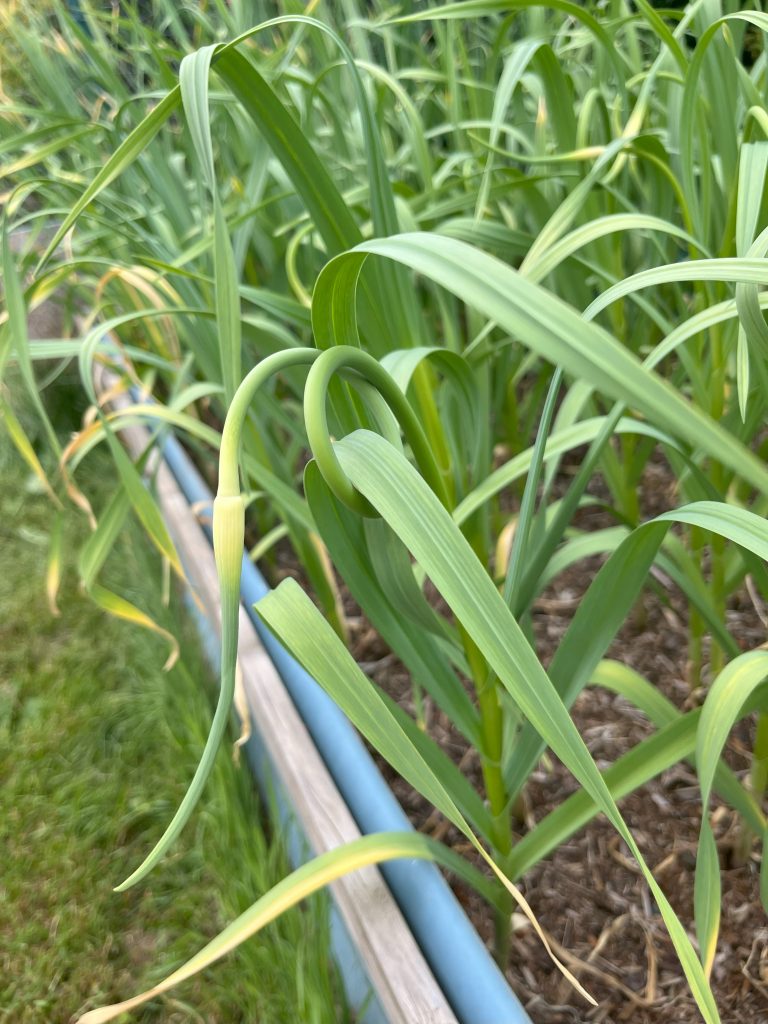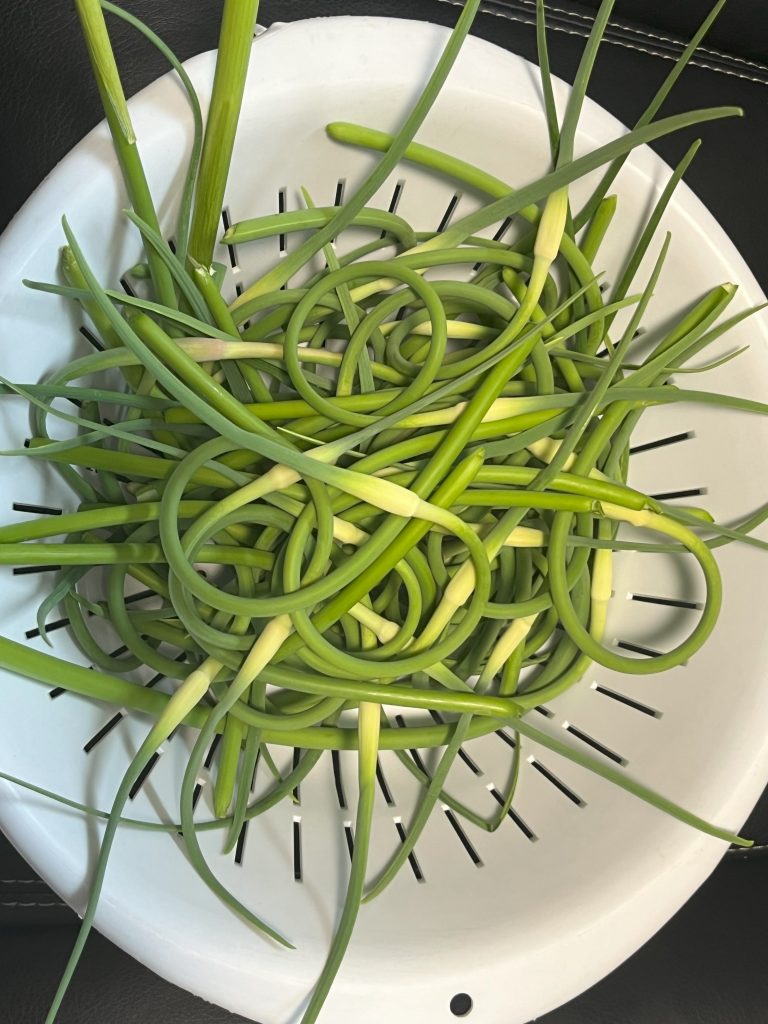Garlic Scapes – Garden to Table
Garlic scapes, the curly, vibrant green shoots that emerge from hardneck garlic plants, are a culinary gem often overlooked in favor of their more famous bulbs. These tender, mildly garlicky stalks offer a unique flavor and texture that can elevate a wide variety of dishes. Understanding what these delicious scapes are, how and when to harvest them, and how to incorporate them into recipes can open up a new world of culinary possibilities.

What Are Garlic Scapes?
Garlic scapes are the flower stalks of hardneck garlic plants. As the plant matures, it sends up a long, curling shoot from the center of its leaves. This shoot, the scape, eventually forms a flower bud, but for culinary purposes, it is harvested before the bud opens. They have a more delicate and less pungent flavour compared to garlic cloves, making them versatile in a variety of dishes. They are often described as having a slightly sweet, oniony flavor with a hint of garlic.
When and How to Harvest Garlic Scapes
Timing is crucial when it comes to harvesting the scapes. The ideal time to harvest them is in late spring to early summer, typically a few weeks before the garlic bulbs themselves are ready. The scapes should be harvested when they are young and tender, usually when they are 8-10 inches long and have just started to curl.

To harvest scapes, simply snap or cut them off at the base, just above the topmost leaves of the garlic plant. It’s important to do this before the scapes become too woody and tough. Harvesting scapes not only provides you with a delicious ingredient but also directs the plant’s energy towards growing a larger bulb.
Culinary Uses
Garlic scapes are incredibly versatile in the kitchen. They can be used in a multitude of ways, from raw in salads to cooked in various dishes. Here are a few delightful recipes to help you make the most of this seasonal delicacy:
Garlic Scape Pesto
Ingredients:
– 1 cup chopped garlic scapes
– 1/2 cup grated Parmesan cheese
– 1/2 cup nuts (pine nuts, walnuts, or almonds)
– 1/2 cup olive oil
– Salt and pepper to taste
– Juice of half a lemon (optional)
Instructions:
1. Combine the chopped garlic scapes, Parmesan cheese, and nuts in a food processor.
2. Pulse until the mixture is finely chopped.
3. With the food processor running, slowly pour in the olive oil until the mixture is smooth and creamy.
4. Season with salt and pepper to taste. Add lemon juice if desired for a bit of brightness.
5. Use immediately, or store in an airtight container in the refrigerator for up to a week.
This pesto can be used on pasta, as a spread on sandwiches, or as a flavorful dip for vegetables.
Pickled Garlic Scapes
Ingredients:
– 1 pound garlic scapes, trimmed and cut into pieces to fit jars
– 2 cups white vinegar
– 2 cups water
– 1/4 cup kosher salt
– 1 tablespoon sugar
– 1 teaspoon black peppercorns
– 1 teaspoon mustard seeds
– 1 teaspoon dill seeds
Instructions:
1. Sterilize your jars and lids by boiling them in water for 10 minutes.
2. In a large saucepan, combine the vinegar, water, salt, and sugar. Bring to a boil, stirring until the salt and sugar are dissolved.
3. Place the garlic scapes into the jars, along with the peppercorns, mustard seeds, and dill seeds.
4. Pour the hot brine over the garlic scapes, leaving about 1/2 inch of headspace at the top of each jar.
5. Seal the jars and process them in a boiling water bath for 10 minutes.
6. Let the pickles sit for at least a week before opening for the best flavor. Store in a cool, dark place.
Pickled garlic scapes are a tangy and crunchy addition to salads, charcuterie boards, or even as a garnish for cocktails.
Sautéed Garlic Scapes
Ingredients:
– 1 bunch garlic scapes
– 2 tablespoons olive oil
– Salt and pepper to taste
– 1 tablespoon lemon juice
Instructions:
1. Heat the olive oil in a large skillet over medium heat.
2. Add the garlic scapes and sauté for 5-7 minutes, until they are tender and starting to brown.
3. Season with salt and pepper, then add the lemon juice. Toss to combine.
4. Serve immediately as a side dish or toss with pasta for a quick and flavorful meal.
Garlic Scape and Potato Soup
Ingredients:
– 1 bunch garlic scapes, chopped
– 4 large potatoes, peeled and diced
– 1 onion, chopped
– 4 cups vegetable broth
– 1 cup heavy cream
– 2 tablespoons butter
– Salt and pepper to taste
Instructions:
1. In a large pot, melt the butter over medium heat. Add the onions and garlic scapes and cook until softened, about 5 minutes.
2. Add the potatoes and vegetable broth. Bring to a boil, then reduce heat and simmer until the potatoes are tender, about 20 minutes.
3. Puree the soup using an immersion blender or in batches in a regular blender until smooth.
4. Stir in the heavy cream and season with salt and pepper to taste.
5. Serve hot, garnished with a drizzle of olive oil or a sprinkle of fresh herbs.

Conclusion
Garlic scapes are a delightful and versatile ingredient that deserve a place in your kitchen. By understanding what they are, how to harvest them, and how to use them in various recipes, you can make the most of this seasonal delicacy. Whether you’re whipping up a batch of pesto, pickling them for later use, or incorporating them into a hearty soup, they bring a unique and delicious twist to your culinary repertoire.
